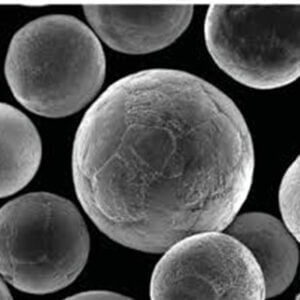プラズマ回転電極プロセス(PREP)
目次
プラズマ回転電極プロセスの概要
について プラズマ回転電極プロセス (PREP) は、優れた純度と均一性を備えた高品質の金属粉末を製造する高度な方法です。これらの粉末は、積層造形、航空宇宙部品、医療用インプラントなど、さまざまな用途に不可欠です。PREP では、回転する金属棒の端をプラズマアークで溶かし、液滴を噴出させて微細粉末に固化します。このプロセスは、優れた流動性と充填密度を備えた球状粒子を生成することで知られています。
プラズマ回転電極プロセスの主な詳細:
- プロセス プラズマアークを利用して回転する金属棒を溶かします。
- 出力: 高純度の球状金属粉末。
- アプリケーション 付加製造、航空宇宙、医療用インプラントなど。
- メリット 高純度、優れた流動性、均一な粒子サイズ。
- 制限: コストが高く、設備が複雑で、特定の金属に限定されます。

PREPが製造する金属粉末の種類
一般的な金属粉末:
| 金属粉末 | 構成 | プロパティ | 特徴 |
|---|---|---|---|
| チタン(Ti) | 純チタンまたはTi-6Al-4V | 高強度、耐食性 | 生体適合性、軽量 |
| ニッケル(Ni) | 純NiまたはNi基超合金 | 高温耐性 | 優れた耐クリープ性 |
| コバルト | 純CoまたはCo-Cr合金 | 耐摩耗性、強度 | 歯科および整形外科用インプラントに使用 |
| アルミニウム(Al) | 純AlまたはAl-Si合金 | 軽量、良好な導電性 | 優れた加工性 |
| ステンレス鋼 | 各種SSグレード(304、316など) | 耐食性、強度 | 多用途、幅広く使用可能 |
| 銅(Cu) | 純銅 | 優れた導電性 | 電気部品に使用 |
| タングステン(W) | 純WまたはW合金 | 高密度、耐熱性 | 航空宇宙および防衛分野で使用 |
| 鉄(Fe) | 純鉄または鉄ベースの合金 | 磁気特性、強度 | エンジニアリングアプリケーションで広く使用されています |
| ジルコニウム(Zr) | 純ZrまたはZr合金 | 耐食性、生体適合性 | 原子炉や医療に使用されている |
| モリブデン (Mo) | 純MoまたはMo合金 | 高温強度 | 航空宇宙および電子機器に使用される |
の応用 プラズマ回転電極プロセス
代表的な用途
| 申し込み | 説明 |
|---|---|
| アディティブ・マニュファクチャリング | 金属粉末を層ごとに積層して複雑で高強度の部品を生産 |
| 航空宇宙部品 | 航空機や宇宙船向けの軽量で高性能な部品の製造 |
| 医療用インプラント | 歯科用および整形外科用デバイスなどの精密な形状を持つ生体適合性インプラントの作成 |
| 自動車産業 | 軽量で耐久性のある自動車部品の製造 |
| エネルギー部門 | 原子炉および発電所の部品の製造 |
| エレクトロニクス | 電子機器用導電部品およびヒートシンクの製造 |
| 金型 | さまざまな業界向けに耐久性と高精度に優れた工具や金型を製作 |
仕様、サイズ、等級、規格
詳細仕様:
| 金属粉末 | サイズ (µm) | グレード | 規格 |
|---|---|---|---|
| チタン(Ti) | 15-45, 45-90, 90-150 | グレード1、グレード2 | アストレムB348、アストレムF67 |
| ニッケル(Ni) | 10-50, 50-100 | インコネル625、718 | ASTM B883 |
| コバルト | 10-45, 45-100 | CoCrMo、CoCrW | アストレムF75、アストレムF1537 |
| アルミニウム(Al) | 10-50, 50-150 | 6061, 7075 | ASTM B928、ASTM B209 |
| ステンレス鋼 | 15-45, 45-90 | 304、316L | A276, A240 |
| 銅(Cu) | 15-45, 45-90 | C10100、C11000 | アストレムB152、アストレムB187 |
| タングステン(W) | 10-45, 45-150 | ピュアW | ASTM B777 |
| 鉄(Fe) | 10-50, 50-100 | 純鉄、FeSi | ASTM A848 |
| ジルコニウム(Zr) | 15-45, 45-90 | Zr702、Zr705 | ASTM B550 |
| モリブデン (Mo) | 10-45, 45-100 | ピュアモ | ASTM B387 |
サプライヤーと価格詳細
金属粉末サプライヤー:
| サプライヤー | 提供する金属粉末 | 価格(1kgあたり) | 追加サービス |
|---|---|---|---|
| エーピーアンドシー | Ti、Ni、Co、Al、SS、Cu、W、Fe、Zr | $150 – $500 | カスタム粒度分布 |
| GKNアディティブ | Ti、Ni、Co、Al、SS、Cu、W、Fe、Zr | $100 – $450 | 研究開発サポート、カスタム合金開発 |
| カーペンター・テクノロジー | Ti、Ni、Co、Al、SS、Cu、W、Fe、Zr | $120 – $480 | 材料試験、認証 |
| LPWテクノロジー | Ti、Ni、Co、Al、SS、Cu、W、Fe、Zr | $130 – $490 | 粉末リサイクル、特性評価 |
| ヘガネス | Ti、Ni、Co、Al、SS、Cu、W、Fe、Zr | $110 – $470 | アプリケーションエンジニアリング、サポート |
プラズマ回転電極プロセスの利点と限界
長所と短所:
| アスペクト | メリット | 制限事項 |
|---|---|---|
| 粒子形状 | 高い流動性と充填密度を備えた球状粒子を生成 | 粒度分布の制御が限定的 |
| 純度 | 不活性雰囲気と最小限の汚染による高純度粉末 | 生産コストと設備コストが高い |
| 均一性 | 均一な粒子サイズと組成 | 機器の取り扱いとメンテナンスの複雑さ |
| 汎用性 | 幅広い金属と合金に適しています。 | すべての金属に適しているわけではありません。球状粒子を形成しない金属もあります。 |
| 品質 | 不純物を最小限に抑えた一貫した品質 | 小規模生産では初期設定と運用コストが高額になる可能性がある |
| アプリケーション | 精度と信頼性が求められるハイテクアプリケーションで広く使用されています | コスト上昇を正当化できる業界に限定 |
金属粉末モデルの詳細分析
チタン(Ti)およびチタン合金:
PREP が製造する純チタン (グレード 1) やチタン合金 (Ti-6Al-4V) などのチタン粉末は、高い強度対重量比、耐腐食性、生体適合性が高く評価されています。これらの特性により、チタン粉末は航空宇宙部品、医療用インプラント、高性能自動車部品に最適です。チタン粉末は優れた流動性を備えており、これは付加製造プロセスにとって非常に重要です。
ニッケル(Ni)およびニッケルベースの超合金:
インコネル 625 および 718 などのニッケル粉末は、酸化およびクリープに対する優れた耐性があるため、高温用途には欠かせません。これらの粉末は、過酷な条件に耐える必要があるタービン ブレードやその他の部品の航空宇宙産業で広く使用されています。PREP で製造されたニッケル粉末は高純度で均一であるため、このような厳しい環境でも最適な性能を発揮します。
コバルト(Co)およびコバルトクロム合金:
コバルト粉末、特に CoCr および CoCrMo 合金は、耐摩耗性と強度に定評があります。これらの特性により、耐久性と生体適合性が重要となる歯科用および整形外科用デバイスなどの医療用インプラントに適しています。PREP で製造されたコバルト粉末の球形と高密度は、これらの用途で優れた性能を発揮するのに貢献します。
アルミニウム(Al)およびアルミニウム合金:
6061 合金や 7075 合金などのアルミニウム粉末は、軽量で導電性に優れていることから高く評価されています。これらの粉末は、燃料効率と性能を向上させる軽量コンポーネントを製造するために、自動車産業や航空宇宙産業で広く使用されています。PREP によって生成される微細な球状粒子は、優れた流動性と充填密度を保証するため、積層造形に最適です。
ステンレススチール:
ステンレス鋼粉末(グレード304および316Lを含む)
強度、耐腐食性、汎用性のバランスが取れています。これらの粉末は、耐久性と製造の容易さから、建設から医療機器まで、さまざまな業界で使用されています。PREP プロセスにより、ステンレス鋼粉末は一貫した品質と均一な粒子サイズを保ちます。これは、信頼性の高いパフォーマンスに不可欠です。
銅(Cu)および銅合金:
C10100 や C11000 などの銅粉末は、その優れた電気伝導性と熱特性に欠かせません。これらの粉末は、電子機器、電気部品、熱交換器に広く使用されています。PREP で製造された銅粉末は純度が高く、球形であるため、これらの用途でのパフォーマンスが向上し、効率的な伝導性と熱伝達が保証されます。
タングステン(W)およびタングステン合金:
タングステン粉末は高密度と耐熱性で知られており、航空宇宙産業や防衛産業での用途に適しています。PREP が製造する球状粒子は均一な充填と流動性を確保し、ロケット ノズルや放射線遮蔽などの高性能部品の製造に不可欠です。
鉄(Fe)および鉄ベースの合金:
純鉄や鉄シリコン合金などの鉄粉は、その磁気特性と強度により、エンジニアリング用途で広く使用されています。これらの粉は、磁気コアや構造部品などのコンポーネントの製造に不可欠です。PREP プロセスにより、一貫したパフォーマンスに不可欠な高純度と均一な粒子サイズが確保されます。
ジルコニウム (Zr) およびジルコニウム合金:
Zr702 や Zr705 などのジルコニウム粉末は、耐腐食性と生体適合性が高く評価されています。これらの特性により、インプラントや手術器具などの医療用途や原子炉での使用に最適です。PREP で製造されたジルコニウム粉末は球形と高純度であるため、これらの重要な用途で信頼性の高いパフォーマンスが保証されます。
モリブデン (Mo) およびモリブデン合金:
モリブデン粉末は、高温強度と導電性が高く評価されています。これらの粉末は、航空宇宙産業やエレクトロニクス産業で、過酷な条件に耐える必要のある部品に使用されています。PREP プロセスにより、均一な粒子サイズと高純度のモリブデン粉末が生成され、要求の厳しい用途でもその効果を発揮します。

よくあるご質問
| 質問 | 答え |
|---|---|
| 何ですか プラズマ回転電極プロセス (準備)? | PREP は、回転する金属棒の先端をプラズマアークで溶かして、高純度の球状金属粉末を製造する方法です。 |
| PREP を使用して処理できる金属は何ですか? | PREP は、チタン、ニッケル、コバルト、アルミニウム、ステンレス鋼、銅、タングステン、鉄、ジルコニウム、モリブデンなど、幅広い金属を処理できます。 |
| 金属粉末の製造に PREP を使用する利点は何ですか? | PREP は、高純度、均一な粒子サイズ、優れた流動性、球状粒子を生成する能力を備えており、ハイテク用途に最適です。 |
| PREP の制限は何ですか? | このプロセスは高価で、複雑な装置を必要とし、すべての金属に適しているわけではありません。さらに、粒子サイズの分布を制御することも困難です。 |
| PREP で製造された粉末は積層造形にどのように使用されますか? | これらの粉末は、複雑で高強度のコンポーネントを層ごとに作成するための付加製造に使用され、重要なアプリケーションで精度と信頼性を提供します。 |
| 金属粉末において球状粒子が重要なのはなぜですか? | 球状粒子は流動性と充填密度を向上させます。これは、付加製造や粉末冶金などの用途で一貫したパフォーマンスを実現するために重要です。 |
| PREP は医療用インプラント用の金属粉末の製造に使用できますか? | はい、チタンやコバルトクロム合金などの PREP で製造された粉末は、精密な形状の生体適合性医療用インプラントを作成するためによく使用されます。 |
| PREP で製造されたニッケル基超合金の主な用途は何ですか? | PREP が製造するニッケルベースの超合金は、優れた耐酸化性と耐クリープ性を備えているため、航空宇宙産業のタービンブレードなどの高温用途に使用されています。 |
| PREP で製造された粉末のコストは他の方法と比べてどうですか? | PREP で製造された粉末は、プロセスと装置のコストが高いため、一般的に高価ですが、重要な用途に対して優れた品質と性能を提供します。 |
| PREP プロセスには環境上の懸念事項はありますか? | PREP は不活性雰囲気で実行されるため、汚染や環境への影響は最小限に抑えられますが、プロセスのエネルギー集約的な性質が懸念される可能性があります。 |
結論
プラズマ回転電極プロセス (PREP) は、さまざまな高度な用途に不可欠な高品質の金属粉末を製造するための優れた方法として際立っています。航空宇宙部品から医療用インプラントまで、PREP で製造された粉末の純度、均一性、球形により、優れた性能と信頼性が保証されます。このプロセスにはコストが高く、複雑な設備が必要ですが、その利点により、精度と品質が最も重要である業界では貴重な技術となっています。技術が進歩するにつれて、PREP のさらなる革新により、その効率が向上し、適用範囲が広がり、材料科学とエンジニアリングの将来におけるその役割が確固たるものになるでしょう。
シェアする
MET3DP Technology Co., LTDは、中国青島に本社を置く積層造形ソリューションのリーディングプロバイダーです。弊社は3Dプリンティング装置と工業用途の高性能金属粉末を専門としています。
関連記事
Met3DPについて
最新情報
製品

3Dプリンティングと積層造形用金属粉末

















